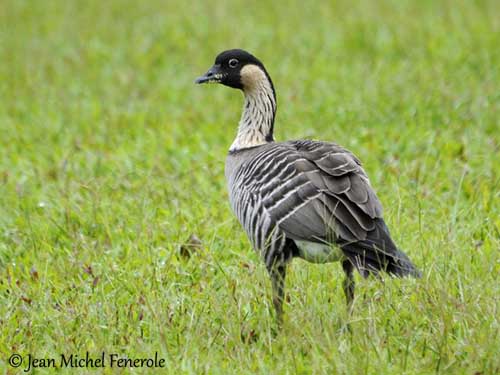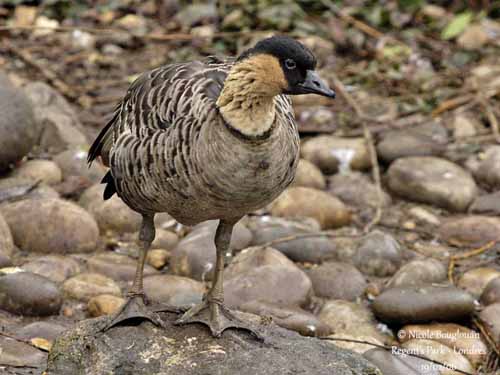
Fr: Bernache néné
All: Hawaiigans
Esp: Barnacla Nené
Ita: Oca delle Hawaii
Nd: Hawaiigans
Sd: Hawaiigås
Photographers:
Jean Michel Fenerole
Photos d’Oiseaux du monde
Jean-Claude Jamoulle
A la rencontre des Oiseaux
Patrick Ingremeau
TAMANDUA
Nicole Bouglouan
PHOTOGRAPHIC RAMBLE
Text by Nicole Bouglouan
Sources:
HANDBOOK OF THE BIRDS OF THE WORLD vol 1 by Josep del Hoyo-Andrew Elliot-Jordi Sargatal - Lynx Edicions - ISBN: 8487334105
GUIDE DES CANARDS, DES OIES ET DES CYGNES – de Steve Madge - Delachaux et Niestlé - ISBN: 2603013769
L’ENCYCLOPEDIE MONDIALE DES OISEAUX - Dr Christopher M. Perrins - BORDAS - ISBN: 2040185607
BirdLife International (BirdLife International)
Designing a Future for Hawaii's Wildlife: Planning for Species of Greatest Conservation
Animal Diversity Web (University of Michigan Museum of Zoology)
Wikipedia, the free encyclopaedia
Hawaiian Goose or Nene
Branta sandvicensis
Anseriformes Order – Anatidae Family
INTRODUCTION:
The Hawaiian Goose is the official state bird of Hawaii since 1957. This goose is slightly different from other geese, due to its sedentary life. This species does not suffer harsh weather. It has weak wings because it does not fly outside Hawaii or migrate. As it rarely swims, its feet are only partially webbed. However, legs and toes are longer than in other species, allowing the bird to climb on the rocky grounds of this island.
Another beautiful adaptation and natural evolution!

DESCRIPTION OF THE BIRD:
Biometrics:
Length: 56-71 cm
Weight: M: 2215 g – F: 1930 g
The adult has brownish upperparts, flanks and breast, with pale buff-edged feathers making barred pattern. Rump and tail are black, with white uppertail-coverts. The wing coverts are brown with darker centres, whereas the flight feathers are darker brown and uniform.
The underwing is pale brown. Lower belly and undertail-coverts are white.
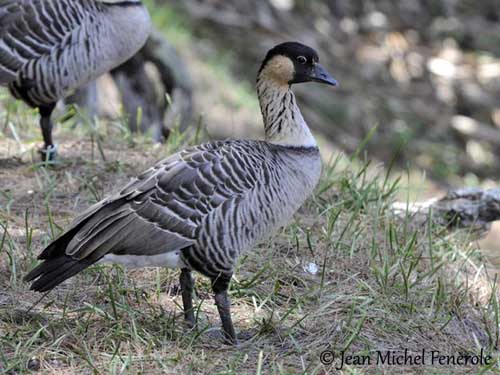
On the head, face, chin, crown, nape and hindneck are brownish-black. Head sides, neck sides and foreneck are golden-buff. Cheeks are washed ochre. A narrow blackish collar is visible at neck base.
We can see striking black diagonal furrows along the neck, similar to heavy black streaking.
The bill is black. Legs and partially webbed feet are blackish and fairly long. The eyes are dark brown, surrounded by narrow whitish eyering.
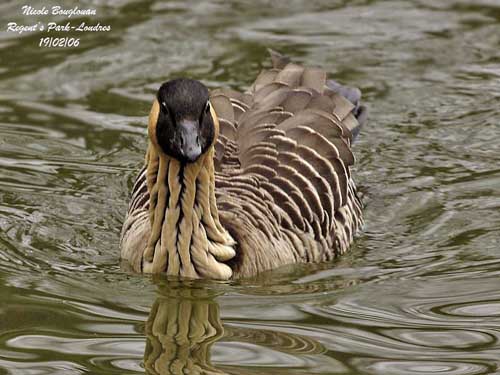
Both sexes are similar, but the male is slightly larger than the female.
The juvenile is duller, with brownish, not black, head and neck. Its body plumage is more scaled than barred. It resembles adult mainly after the first moult.
RANGE:
The Hawaiian Goose is found on Hawaii Island. The species has been reintroduced to Maui Island where there is a small population.
HABITAT:
The Hawaiian Goose frequents the lava flows on volcanic slopes where the vegetation is rare or scattered. It can be found in grassland when available. This species is well adapted to its terrestrial life, and lives in regions without wet areas. It can be seen up to 1500-2500 metres of elevation.
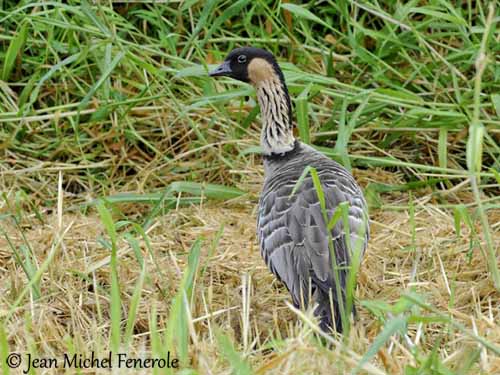
CALLS AND SONGS: SOUNDS BY XENO-CANTO
The Hawaiian Goose’s typical call is a low, plaintive call similar to the name of this species “ne ne”.
These calls become louder and raucous during the displays.
BEHAVIOUR IN THE WILD:
The Hawaiian Goose is mainly vegetarian and feeds primarily on grasses, leaves, green parts of sedges and other plants, seeds and berries. It consumes native and non-native vegetation. Its diet varies according to the habitat, and the bird takes advantage of some non-native grass at high elevation.
It grazes and plucks food items, and forages almost exclusively on land.

The Hawaiian Goose mates for life, involving simple courtship displays. The male attacks or threatens potential rivals before to join the female. It gives loud calls during this behaviour. Copulation takes place on the ground, like in Cape Barren Goose, and unlike other goose species.
They live in family groups between June and September, before the pairs start to breed again.
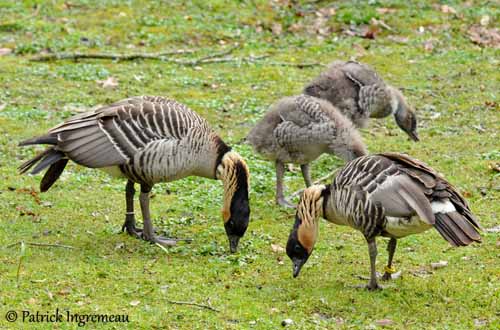
The Hawaiian Goose is mostly sedentary, with only small local movements.
This species can fly, even while moulting. However, it is more terrestrial than good flier. It has weak wings, due to only short-distance flights.


REPRODUCTION OF THIS SPECIES:
The Hawaiian Goose has extended breeding season, with peak between October and March. Females lay mainly between October and December.
They nest in solitary pairs. The nest is made by the female. This is a shallow scrape on the ground with a lining of some vegetation and down. It is usually sheltered by rock or tussock grass. The nest-site is often reused by the pair, year after year.

The female lays 2-5 creamy-white eggs, and she incubates during about one month. At hatching, the chicks are covered with brown down, and they have whitish markings on the underparts and the face too. They are precocial and able to feed themselves, but they usually remain with the adults during one year. They fledge about 10-12 weeks after hatching, and they are sexually mature at 2-3 years old.

PROTECTION / THREATS / STATUS:
The Hawaiian Goose suffered excessive hunting pressure and introduced predators, leading its populations of about 25 000 geese almost to extinction in the late 19th century.
Captive breeding programs started in 1952, both in Hawaii and England, allowing the release of 1000 birds in their wild habitat. In 1976, about 750 geese were alive, against only 30 individuals in 1952.
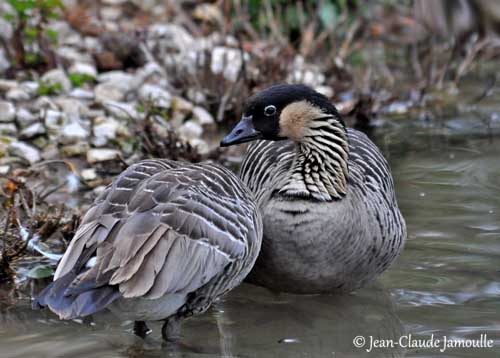
Today, the predation by rats, cats, dogs and Indian mongoose (Herpestes auropunctatus) is continuing. Degradation of the habitat involves low productivity. Human disturbances and mortality due to roads, and lack of lowland habitats affect this species.
Several conservation and protection measures are already active, but the Hawaiian Goose is still listed as Vulnerable, with an estimation of 2500 individuals in 2011 (BirdLife International).
